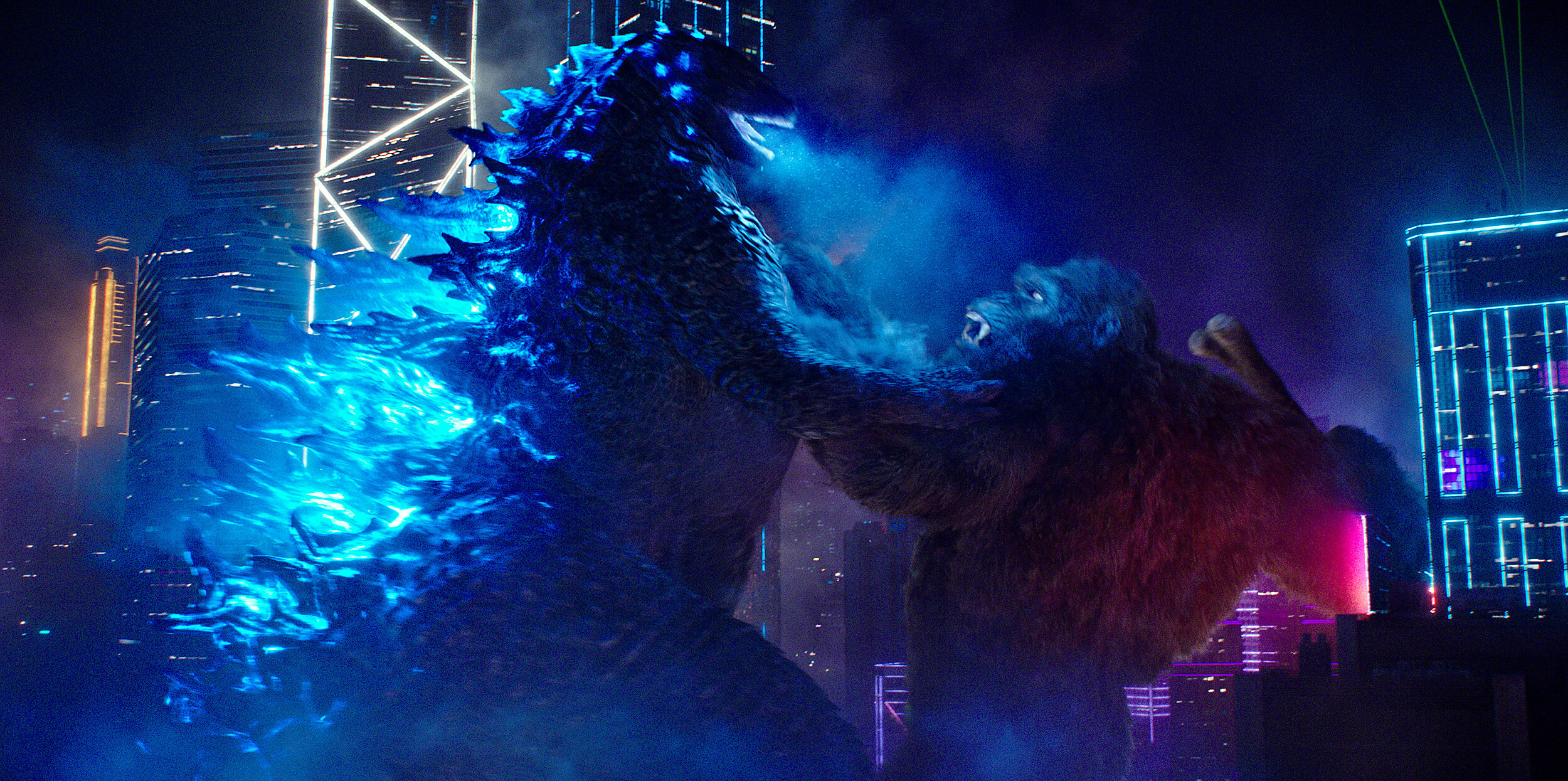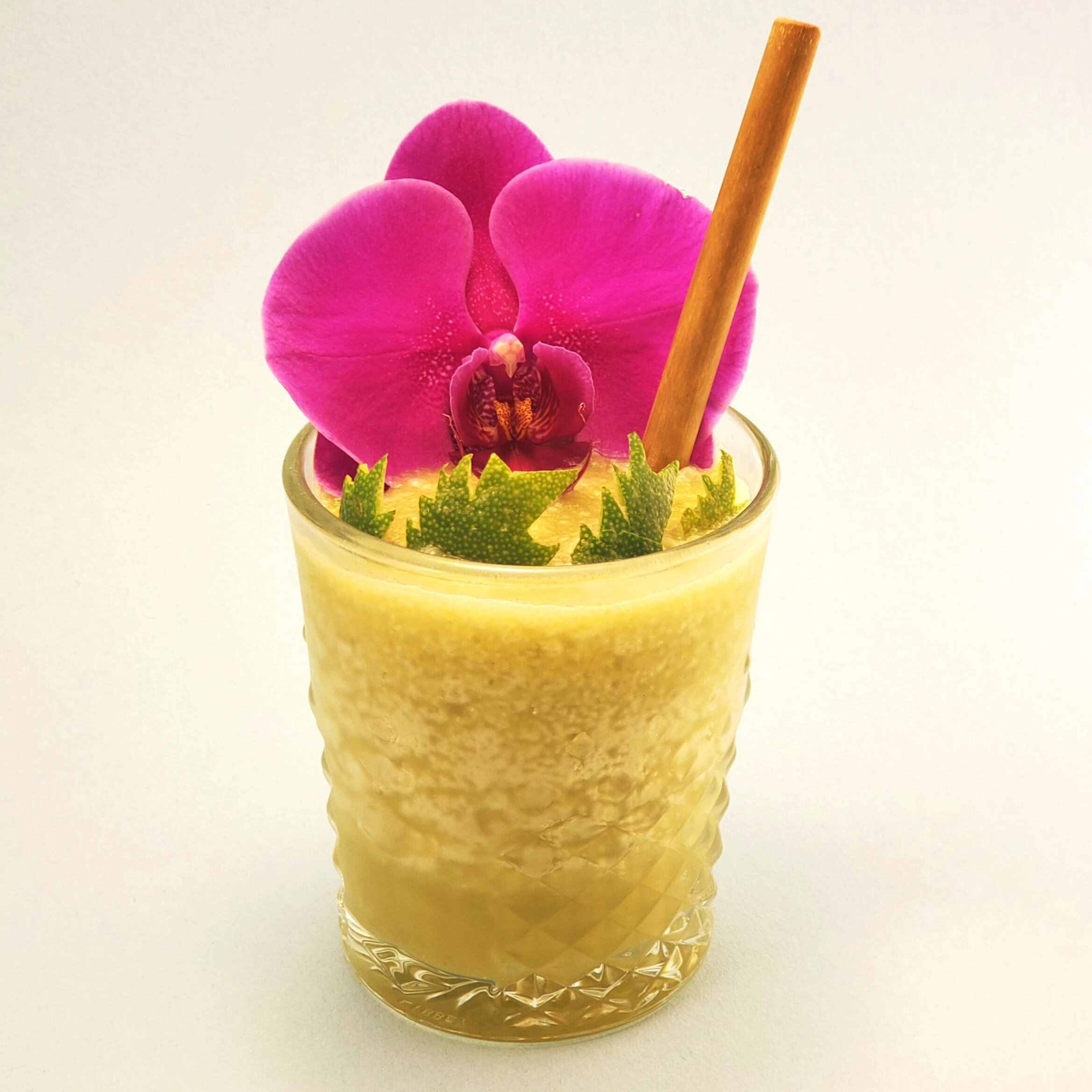Godzilla vs. Kong and Kaiju Kocktails
Image courtesy of IMDB.
Movie: Godzilla vs. Kong
When I sat down to watch Godzilla vs. Kong I had the same tentative excitement I’d had as a child going to the theaters to see Batman Forever, or as a grad school student settling in to watch Transformers: Age of Extinction. That is, I knew what I wanted to see, which was the triumphant depiction of a narrative I knew and loved, but understood that what was actually to come was going to be something far worse: the death of a beloved story at the hands of corporate capitalism.
When Legendary Pictures rebooted the Toho’s classic Godzilla in 2014, I was no newcomer to the denizens of Monster Island. Like 2012’s The Dark Knight Rises’ Bane, I was born in it, molded by it. Had the old toys, even clothing. My father, in particular, had done as much as he could to get ahold of as many Godzilla movies as he could, recording them onto VHS from Columbus’s own WBNS-TV’s “Night Owl Theater” hosted by Fritz the Night Owl. He’d even gotten me a five-foot by eight-foot framed poster for Christmas one year, something he still holds onto in his upstairs closet behind boxes of my grad school books.
And that reboot was good. There was attention taken to the plot and narrative so that the balance of monster to humanity wasn’t overdone. The cinematography, too, was on point. It took itself seriously and did the best it could to make sense of something as absurd as a giant, fire-breathing amphibian. And let’s not forget that Godzilla has always been about making sense of the absurd. When the monster was born in 1954, it was a response to and reflection on atomic weaponry and war, and the fear and harm of radiation. “The theme of the film,” producer Tomoyuki Tanaka said, “was the terror of the bomb. Mankind had created the bomb, and now nature was going to take revenge on mankind.” 2014’s Godzilla recentered that focus onto nuclear power as a source of energy and the subsequent consequences of mankind’s effect on the climate. The monsters in the reboot were forces of nature, also, that mankind had inadvertently awoken but had to deal with, that they had to learn to live with, and the movie was buoyed forward by that seriousness. As the “franchise” gained steam, however, the seriousness was swapped for fan service and the movie quality suffered.
In 2017, Kong: Skull Island delivered us a movie that had always been intended as a stepping stone towards that fanservice. While the movie was, in part, a reimagining of the 1933 original, it was also a little bit Apocalypse Now with Samuel L. Jackson’s Packard a familiar trope at that point, another soldier unable to leave the war behind. But instead of focusing on his trauma, and the vulnerability it could have represented through stone-faced Kong, we had another Ahab and his Ape, the most human-like kaiju to date that was unexplored thematically. Kong appears in Skull Island on the horizon soon after the expedition arrives, and without fanfare. He’s just standing there, backlit by the setting sun, as if the movie makers were saying, “There he is, you animals. I hope you like him.” Throughout the movie, too, he’s displayed but shallow. He could have been tied to the island’s indigenous people as something iconic and undefeatable in the face of the American war machine and imperialism, or he could have been more closely tied to the environment and the consequences of war (cough cough Agent Orange cough cough). Instead, he smashes and roars and fights; he’s just another war-like aspect personified, concretized, that Jackson’s Packard can rush headlong towards full of rage at instead of the bureaucratic and political machinery of the Vietnam War he can’t affect and to which he gave so much of his life.
It should come as no surprise to viewers of Godzilla vs. Kong that, duh, Godzilla would win in a fight, kaiju a kaiju. Unquestionable things aside, like the fact that Godzilla is amphibious, scaled, and breathes atomic flame, the monster was conceived from stronger stuff: the atomic bomb. Nuclear fallout. Humanity’s might and place within the hierarchy of the natural world. All of what Godzilla embodies is impenetrable existentialistic and naturalistic concepts that existed before Godzilla first terrorized Tokyo and will exist forever after. Kong, on the other hand, was inspired by white 1930’s escapism spurred on by the Great Depression and fueled by the not-so-unfamiliar racism of the time, quintessentially softer ideals.
When Kong arrived on the scene in 1933, first as a novel then the classic stop motion movie, he was the embodiment of America’s fetishization of the “exotic” and a racism-driven fear. Kong, a giant ape on Skull Island to whom a white woman was offered as sacrifice, is taken back to America in chains to be displayed as the Eighth Wonder of the World for affluent white people, and when he breaks his chains and kidnaps the same white woman again (whom he thinks he’s protecting), he’s shot by fighter planes at the top of a building. The final classic lines still live on to this day: “Oh no, it wasn’t the airplanes [that killed Kong]. It was beauty killed the beast.” Of course it was the planes, though, and their pilots that killed Kong and not Kong “being where he shouldn’t be,” which is some blame-game bullshit that plays out in our court rooms to this day regarding policing and the unnecessary murder of Black Americans.
Built on fear, Kong was always a strawman for white America, and his questionable appearance in the new Godzilla “monsterverse” is problematic, too, mostly because he’s boring and poorly suited for the setting but also because he’s not re-envisioned, and he’s not recontextualized. He’s the same problem in HD. Godzilla breathes fire. Ghidorah is an alien that regenerates lost heads and shoots lightning from its mouth. Rodan has flaming wings. Even Mothra is at least useful in death, helping to supercharge Godzilla’s defeat of Ghidorah in King of the Monsters. Kong is just America, shoehorning itself into everything.
And Godzilla vs. Kong was terrible, as terrible as every childhood memory that Michael Bay stole from me and rebooted, and somehow managed to make more puerile than the source material. Transformers and Teenage Mutant Ninja Turtles was absolutely wrecked by the touch of Bay.
In Godzilla vs. Kong there didn’t need to be a hollow Earth large and teeming with life, nor a temple built by ancestor Kongs; there didn’t need to be the conspiracy theory pod caster who teams up with two children—a smart one and a fat, foreign one—to “save the world.” Even more problematic was that the indigenous people from Skull Island were written out instead of included, killed by the storm surrounding the island except for the one deaf child that survived and is taken care of by a white American woman who also happens to be Kong’s handler. I don’t know why there weren’t more lead actors of color, or why, if Kong’s axe is made from a Godzilla dorsal plate, that the movie didn’t center around getting the plate off of Godzilla and using Kong to do it. Truly, this movie was unnecessarily complicated and made so for money’s sake. Like Transformers: Age of Extinction the vast Chinese market was not lost on the producers, and so the final scenes were moved unnecessarily to Hong Kong (despite the enormous humanitarian issues plaguing the country).
But like so many things I’ve loved and seen remade time and again, there’s always another chance to get it right. After Batman Forever came Batman Begins which brought me back to the Dark Knight who I’ve always been a champion for, and the Marvel movies have been mostly solid storytelling even with the fanservice—perhaps despite it. And, of course, there’s Godzilla from 2014 which is still a banger. And while Godzilla vs. Kong left me wanting, I’ll admit that when I watched Godzilla: King of the Monsters recently I teared up again when Ken Watanabe’s Serizawa said in his final moments, with his hand on a gravely wounded Godzilla’s snout and a nuclear bomb primed to blow, “Farewell, old friend.” And like wise Serizawa, I, too, know that Godzilla will endure for my lifetime, for many lifetimes, to return better than before even despite Kong’s tagalong antics. Long live the (corporate) king.
Kaiju Kocktails
Cocktail: King of the Monsters
Go go Godzilla, yeah
History shows again and again
How nature points out the folly of men
Godzilla
History shows again and again
How nature points out the folly of men
Go go Godzilla, yeah— “Godzilla”
Blue Öyster Cult
King of the Monsters is a blended, frozen drink that’s deceptively powerful thought no one’s surprised. Matcha powder comes together with Nolet’s gin and Islay scotch with otherwise Tiki elements to create a drink to rule the rest. Pineapple, coconut cream, orgeat, and Hellfire bitters make this a beast above the others, ready to take it’s place on the throne as Apex Titan.
King of the Monsters
3/4tsp Matcha Powder
2oz Frozen Pineapple Chunks
1oz Lime Juice
1oz Orgeat
1oz Cream of Coconut
2oz Nolet’s Silver Gin
2oz Islay Scotch (Ardbeg)
4 dashes Bittermens Hellfire Habanero Shrub
6oz Crushed or Pellet Ice
Add all ingredients to a blender and blend for 20-30 seconds.
Pour into glass and garnish with lime peel dorsal plates.
Stomp and roar! Present yourself as the rightful King of Monsters (and make sure to look your boss in the eye during the Zoom meeting when you do so, your majesty).
Cocktail: Kong’s Axe
Kong's a pretty good king. Keeps to himself, mostly. This is his home, we're just guests. But you don't go into someone's house and start dropping bombs, unless you're picking a fight.
—Hank Marlow, Kong: Skull Island
Kong’s Axe is a powerful thing. Like Kong himself, it’s built with familiar American rye whiskey and exotic Jamaican pot still rum. It’s fortified with banana liqueur and sherry, and emboldened further with aromatic and cardamom bitters. It’s strong enough to bring down the mightiest of kings.
Kong’s Axe
1.5oz Rye Whiskey
0.5oz Jamaican Pot Still Rum, overproof
0.75oz Giffard’s Banane du Bresil
0.5oz Amontillado Sherry
2 dashes Angostura Bitters
2 dashes Cardamom Bitters
Add all ingredients to a tin and then add ice; stir for 40 revolutions.
Strain into a coupe glass with an ancestral weapon garnish.
Defy your origins, escape your captors, and become the king or queen you were meant to be.







